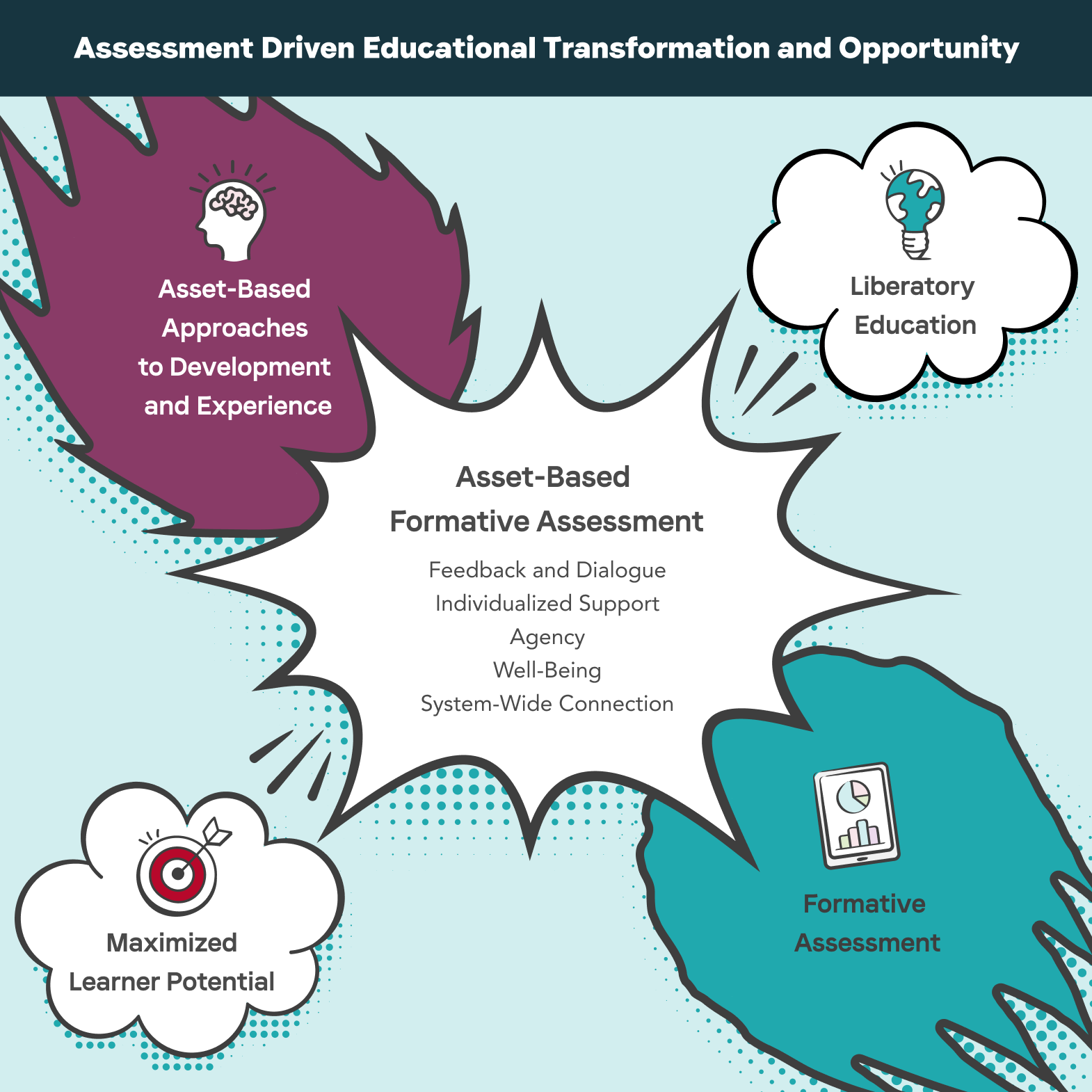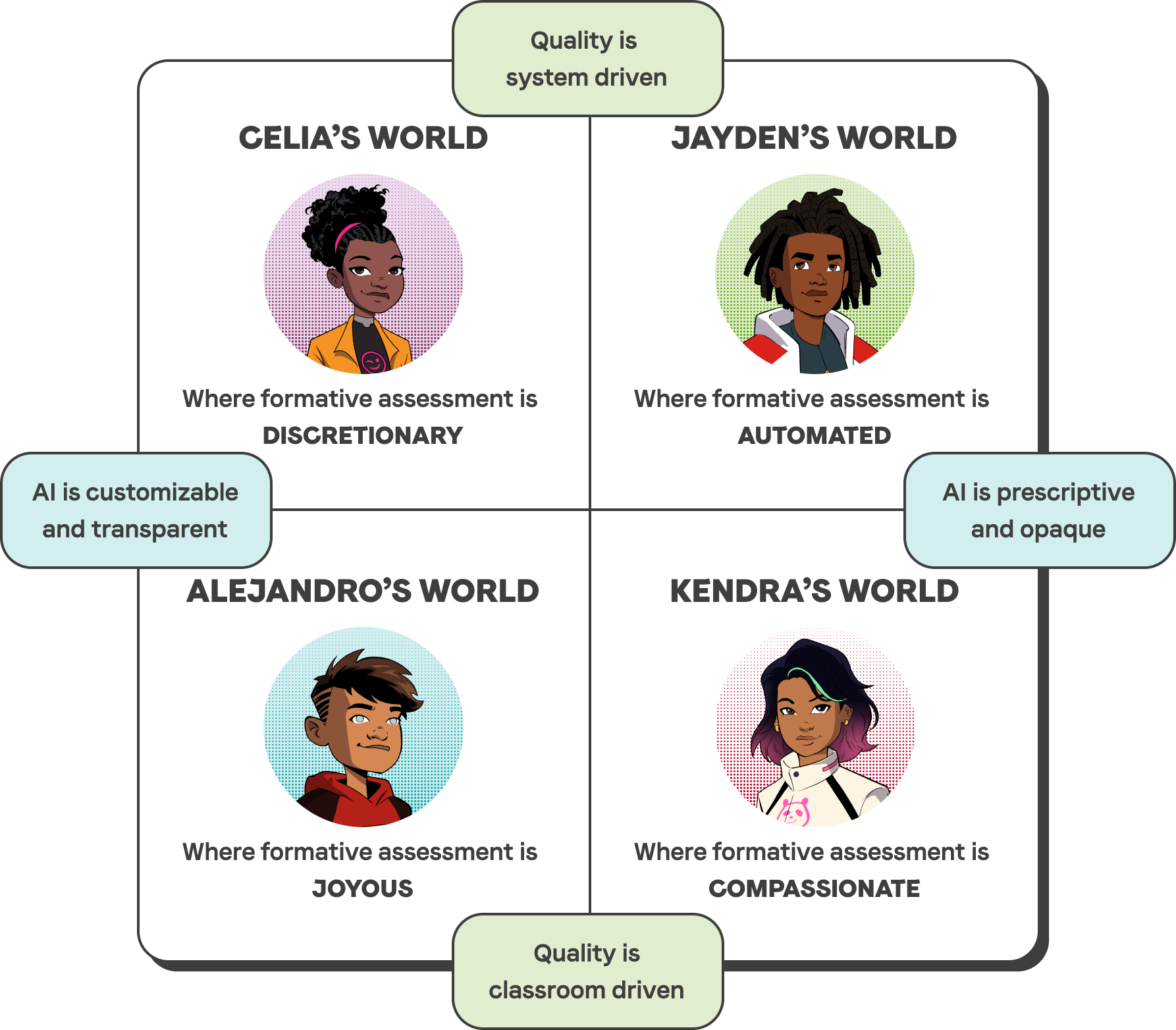Assessment as a Catalyst for Change
How might new approaches to assessment help transform education? Depending on how it is used, specifically its framing and purpose, assessment can be a powerful catalyst for change. Assessment can support learning by providing learners with the opportunity to identify their talents and explore their interests. It can also help them embrace how they are growing as young people. In formative assessment experiences, learners can be exposed to new ideas and experiences. They can show their brilliance in ways that align with who they are.
Too often, our systems of education take a deficit view of learners, particularly when they think about the full potential that each of them may have. Learners are asked time and time again to prove their intelligence and worth, often while pushing against deep-seated structural and systemic problems inside education and myriad challenges outside it.
In the U.S., education systems and structures are strongly shaped by assessment and accountability systems that prioritize the use of data to show school outcomes and performance rather than learner brilliance and opportunities for further guidance. If this priority were flipped and assessment and accountability systems generated rich data and insights to support individual learning and growth, education transformation would be possible.
Each learner has a set of assets, such as their identities, talent, mindsets, or personal interests that they use to navigate their world in their own unique way. They often use these assets to power how they learn, in their home, school, or community. Rather than thinking of these assets as benign or a deficit, they become a source of rich information that are combined with high-quality learning experiences, all of which are the building blocks for success.
Defining Asset-Based Formative Assessment
Asset-based formative assessment is a formative assessment process that is used to unveil the strengths and assets of learners, especially those most traditionally underserved by our education system.
Asset-based formative assessment helps educators understand who learners are at any given day or moment. It seeks to uncover and take into account how safe learners feel, their self-awareness and their feelings of connectedness and belonging, all of which ebb and flow depending on many factors in students’ daily lives.
More importantly, it provides this same information to caregivers and the learner as well. With this information, educators then create more supportive and ultimately successful learning experiences for students
Here’s a model for how asset-based formative assessment leads to liberatory education.

Asset-Based Approaches to Development and Experience
Asset-based approaches view diversity in thought, culture and lived experience as positive contributions and strengths of a person. These approaches highlight that all learners have an individualized learning trajectory that is powered by who they are and their unique mindsets – which provides helpful information for learning. Rather than view what is lacking, an asset-based approach uses an individual’s context, knowledge and experience as building blocks for success.
Formative Assessment
As defined by the Council of Chief State School Officers (CCSSO), “Formative assessment is a planned, ongoing process used by all students and teachers during learning and teaching. Its purpose is to elicit and use evidence of student learning to improve student understanding of intended disciplinary learning outcomes and support students to become self-directed learners. Effective use of the formative assessment process requires students and teachers to integrate and embed the following practices in a collaborative and respectful classroom environment:
• Clarifying learning goals and success criteria within a broader progression of learning
• Eliciting and analyzing evidence of student thinking
• Engaging in self-assessment and peer feedback
• Providing actionable feedback
• Using evidence and feedback to move learning forward by adjusting learning strategies, goals, or next instructional steps.”
Liberatory Education
Liberatory education empowers learners to engage critically in shaping the world around them. Liberatory education systems treat each learner as being valuable and capable of leading their own learning in partnership with skilled and caring educators, peers and community members
Five Principles of Asset-Based Formative Assessment
Asset-based formative assessment is grounded in a set of common principles that, when put into intentional practice, drive toward liberatory education experiences for all learners. These core principles are listed below.
Feedback and Dialogue: An ongoing information exchange among learners, educators and caregivers that involves giving, reflecting and acting on feedback to inform all parties at the same time.
Individualized Support: Provides meaningful learning opportunities that consider the ebbs and flows of a learner’s life— providing a responsive approach that considers their unique needs, interests and goals. It allows educators and learners to reflect on how they are showing up in the moment, while also taking a longitudinal view of that learner’s journey.
Agency: Develops a learner’s self-efficacy, will and capacity to act on the world, expanding how, when and where a learner is able to engage in discovery. In support of this, current education systems move toward a more liberatory approach, empowering learners to engage critically in shaping the world around them.
Empowered Learning: Expands the opportunities for high-quality learning that builds upon the core skills a learner has and allows them to link core content knowledge together with essential skills that power the learning process.
System-Wide Connection: Shapes a young person’s learning journey and allows for access to education opportunities that extend into their homes and communities. It leverages the assets each learner has as the main connection point to the new learning opportunities that reflect who they are, their goals, and the high-quality learning opportunities that exist at school and across their community.
Critical Uncertainties About the Future
The scenarios presented in this forecast reflect two critical uncertainties that promise to shape future possibilities. Critical uncertainties are changes and outcomes that seem both highly uncertain and highly impactful. Together, these critical uncertainties will shape the landscape of possibility.
School Quality
How might school quality systems be oriented?
The orientation of school quality measurement systems – and whether the main stakeholders are policymakers or members of the educational community – will have a major impact on the types of assessment practices and processes that are valued and commonly implemented.
School quality is system-driven: The design and implementation of school quality measures support system-level policies and decision-making.
School quality is learning-driven: The design and implementation of school quality measures support teaching and learning at the classroom level.
Artificial Intelligence
What organizing principles might guide the use of AI in assessment?
How AI is developed and deployed will also have a major impact on the future of assessment. While there is little uncertainty around whether AI will be present and affect assessment, there is great uncertainty around what organizing principles will shape how AI shows up in learning and assessment.
AI is customizable and transparent: People have the means to influence when and how they interact with AI. Decision making processes are transparent. AI solutions and outputs are recommendations or suggestions that can be overridden by human agents.
AI is prescriptive and opaque: People do not have the means to influence when and how they interact with AI. Decision making processes are not transparent. AI solutions and outputs are conclusions or directives.
Explore the worlds we’ve imagined from these critical uncertainties.

Tips for Navigating the Future
This forecast was created from a data-driven process that was then seeded with imagination. Over 40 people from across the nation participated in interviews and a set of workshops to power the ideas within this forecast. As they engaged in this work, they were charged with exploring the future as an invitation to let their imagination run wild while also thinking deeply about change.
No one can predict the future, but we can tell plausible stories about what it might contain. These stories represent multiple futures, each of which can inspire us to think and act differently today.
Here are a few helpful tips as you explore the future worlds in this forecast.
- The future is uncertain. It will likely feel different, and perhaps uncomfortable, but that’s okay. That’s where new ideas come from. Try leaning into the uncertainty, as unsettling as it may be, and seeing what insights emerge.
- Ask yourself how you want the future to be different when it comes to assessment— and what actions or changes you might take to shape it.
- Consider what new insights about futures of assessment you can generate by thinking creatively about where current trends and data points might be headed.
We hope that this forecast can help spark new thinking about possibilities for assessment and the actions needed to create a better future for all learners.
Explore the worlds we’ve imagined in 2034

